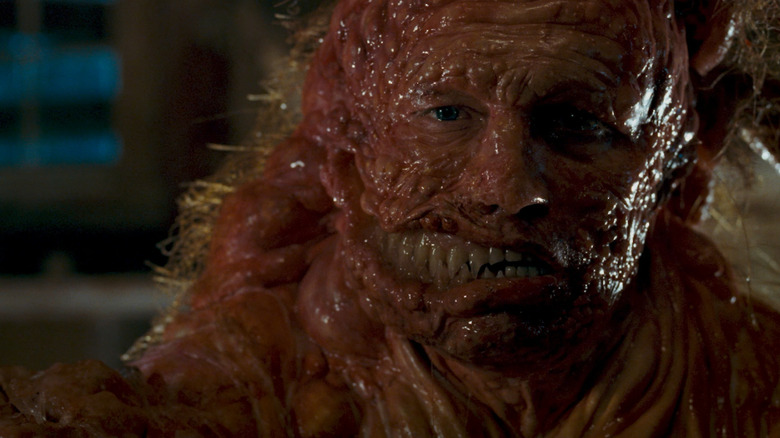
Monsters come in all shapes and sizes. Some are born into their grotesquerie, while others earn that title by way of horrifying transformations. Regardless of their depth or sympathetic origins, characters in horror movies can transform into something horrific for a host of different reasons, from an unfortunate encounter with an alien species, making poor choices (about wigs, holy grails, or experiments), or trying to climb social and career ladders to getting attacked because of your first period.
The /Film horror brain trust put their heads together to come up with this list of truly horrifying transformations to scare you senseless. Whether it's the gradual metamorphosis of one Seth "Brundlefly" Brundle, the more immediate shapeshifting nightmare fuel that is David Kessler's lycanthropic change, or the metaphorical transformation spanning generations in "Relic," the impact remains more or less the same: terrifying.
The Howling (1981)
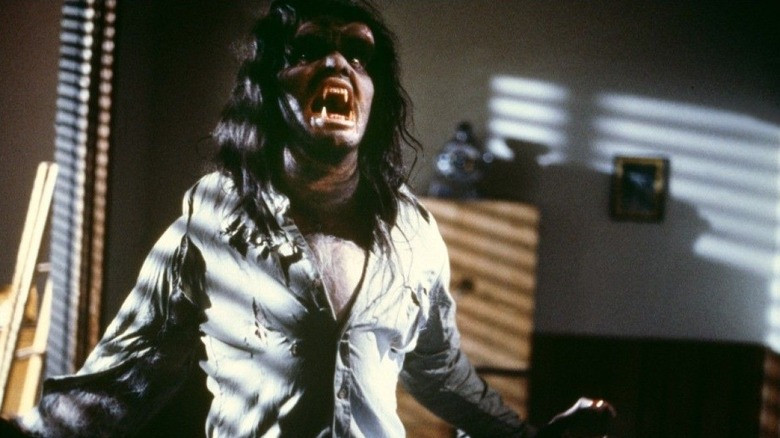
Although the best werewolf transformation of 1981 can be found in "An American Werewolf in London" (at least as far as the Academy is concerned), Joe Dante's film from the same year, "The Howling," is no slouch in the transformation department. The film's werewolves were designed by none other than Rob Bottin, a protegé of "American Werewolf" makeup master Rick Baker. Bottin's use of pulsating air bladders and extendable false faces is just as impressive and innovative as Baker's designs, making the film's main transformation scene a sterling example of body horror.
The moment where Eddie Quist (Robert Picardo) transforms into a killer wolf right in front of Karen White (Dee Wallace) is made as disturbing as possible by Dante. Shot by cinematographer John Hora in shadowy, dangerous blacks, the scene is a literal showstopper, where Eddie forces Karen — and, by extension, the audience — to watch every bone stretch, every hair grow, and every fang extend, paying off the character's (and the film's) conflation of the psychosexual with the supernatural. In this way, the transformation acts as a visual assault before it turns into a physical one, the werewolf equivalent of a killer showing his victim his weapon before using it. (Bill Bria)
Ginger Snaps (2000)
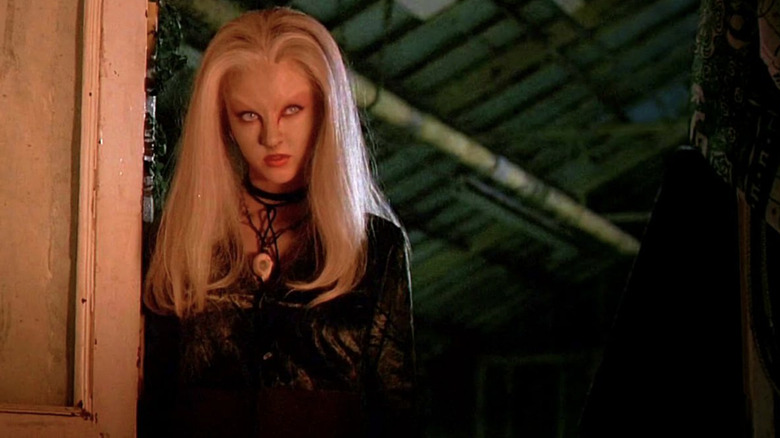
John Fawcett and Karen Walton's coming-of-age horror flick "Ginger Snaps" sees two codependent sisters, Brigitte (Emily Perkins) and Ginger Fitzgerald (Katharine Isabelle), struggle to navigate the social world of high school in Bailey Downs while Ginger slowly transforms into a werewolf. At first, Ginger's newfound lycanthropy makes her feel powerful and in control of her own destiny for the first time in her life, but as the monster inside her grows stronger, her transformation grows increasingly grotesque. By the time Halloween rolls around, Ginger's facial structure has morphed to become progressively more wolflike, as she soon loses any semblance of humanity and fully wolfs out.
"Ginger Snaps" opted for a practical wolf transformation sequence, filled with pulsing veins, cracking bones, painful facial mutations, and extended, gnarled limbs. Ginger's transformation looks absolutely agonizing, but the true tragedy is watching Brigitte desperately try to find her sister from beneath the fanged mouth and white fur. Her transformation isn't just a sign that she's become a monster, it's that she's beyond saving, and her loving sister will have to kill her to prevent further misery. (BJ Colangelo)
The Thing (1982)
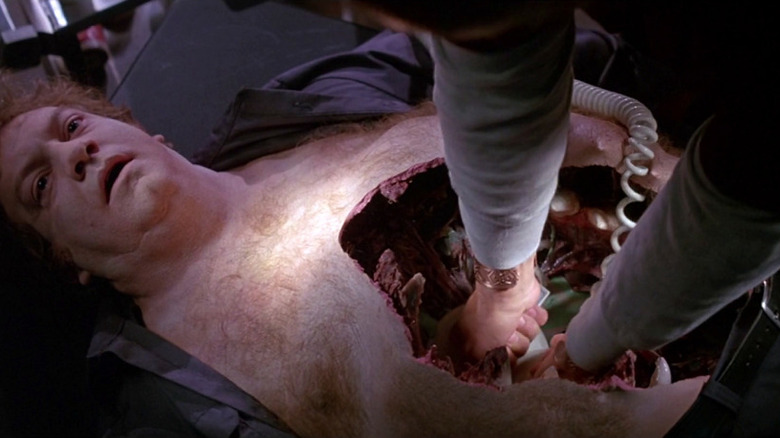
"What I didn't want to end up with in this movie was a guy in a suit," John Carpenter once said.
The director's 1982 film "The Thing" is an adaptation of the 1938 novella "Who Goes There?" by John W. Campbell Jr, which follows a group of Antarctic researchers struggling to survive against a non-human organism that attacks, kills, and imitates its hosts.
The nature of the "thing" means plenty of gnarly transformations during the 109-minute runtime: dogs become grotesque, tentacles slither into orifices, and grown men split in twain in John Carpenter's 1982 classic. The wildest metamorphosis among them is that of Norris (Charles Hallahan), who suffers a heart attack and reacts rather poorly to its treatment. Upon defibrillation, Norris' chest opens into a gaping maw that bites off the good doctor's arms. What emerges is one of the ugliest monsters to grace the big screen, and some of the most exquisite practical effects to do the same.
Creature designer Rob Bottin used an array of substances, from creamed corn and microwaved bubble gum to buckets of lube, to fulfill Carpenter's vision of a shapeshifting monstrosity that's not just some guy in a suit, but an uncanny abomination that defies belief. (Anya Stanley)
The Fly (1986)
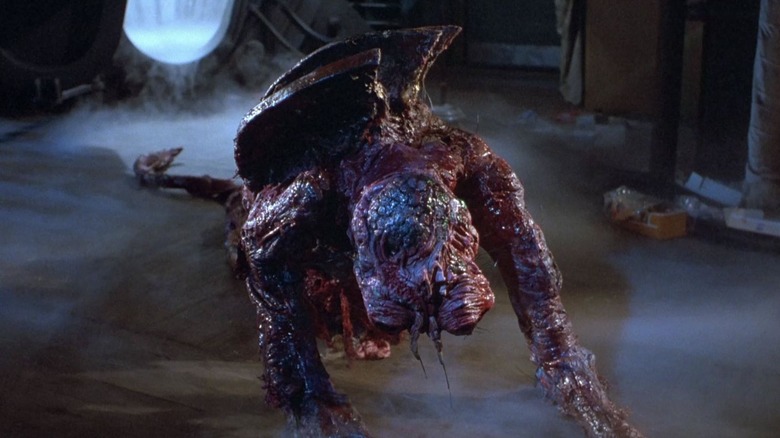
Body horror auteur David Cronenberg's "The Fly" has one of the most grotesque movie monster transformations of all time. The film follows Jeff Goldblum as the brilliant but strange scientist Seth Brundle who experiences a horrifying mutation after an experiment goes awry. In an attempt to operate an invention that allows teleportation between pods, Brundle gets caught in a tragic accident after a housefly gets trapped in the device. Throughout the film, Brundle's DNA begins to hideously merge with the fly, causing a rather brutal transformation that depicts his blood-curdling evolution ... into Brundlefly.
The scientist grapples with his gradual loss of humanity and the terrifying physical changes he's forced to undergo as he helplessly becomes a monster of his own making. But perhaps the goriest moment of them all is when Brundle's skin peels off to reveal an unnatural creature inside him — it's unforgettable, hard to watch, and undeniably iconic. The monster might be a little outlandish, but it's a reminder of how body horror is easily one of the scariest horror sub-genres there is. After all, you can run away from a guy in a hockey mask, but you can't run away from yourself. (Fatemeh Mirjalili)
Candyman (2021)
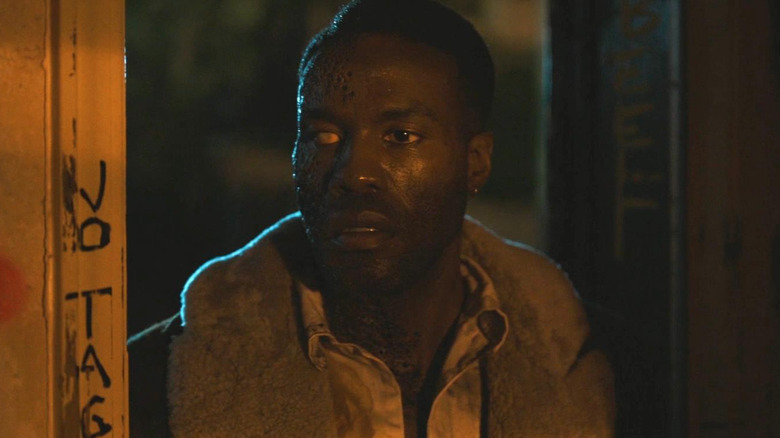
Now an adult, Anthony McCoy (Yahya Abdul-Mateen II) has no memory of his time as an infant in Candyman's lair, but he finds himself drawn to the legend and the grounds of Cabrini-Green. While touring the empty housing project, he's stung on the hand by a bee, beginning his transformation by summoning the murderous ghost in a mirror. The skin of his hand rots and peels with a blistering infection that spreads from the bee sting up his arm and throughout his body. Laundromat owner William Burke (Colman Domingo) completes the conversion by sawing off Anthony's hand and jamming a rusty hook into the stump. He has become the new Candyman.
Though Anthony's metamorphosis is horrifying, the film's allegory terrifies on a deeper level. Simply in the wrong place at the wrong time, Anthony finds himself turned into a monster by a dominant culture that fears him. As he learns more about his community's history, he is consumed by the dehumanizing narrative. Even more horrific are the shadow puppet recreations of actual events in American history in which real Black men have been transformed into boogeymen to fit a narrative built to uphold white supremacy. (Jenn Adams)
The Beast Within (1982)
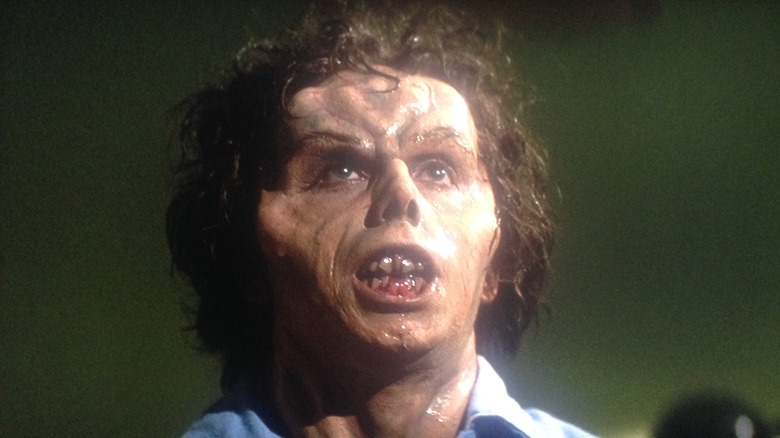
Some transformation sequences are terrifying because of how realistic they seem. Others, like the one from "The Beast Within," are made utterly nightmarish thanks to how surreal they are. There's nothing logical happening on an anatomic or medical level when young Michael MacCleary (Paul Clemens) succumbs to his genetic destiny, transforming into a version of the creature who'd raped his mother Caroline (Bibi Besch) some 17 years prior.
Whether the creature that was Michael's father was a mutant cicada (those creepy insects that come around every 17 years) or not, the film doesn't seem to be sure. Michael's final form looks generically monstrous, with no obvious insect-like attributes. However, there's no doubt that Michael's transformation into the beast is genuinely upsetting: Clemens writhes and spits violently during the event, the skin-stretching bladder effects making his head pulsate while a puppet creature is occasionally inserted between cuts. Most disturbingly, the crowd of people surrounding Michael stand silently and watch him, barely reacting beyond their general expressions of shock and horror. It's an example of how '80s horror put such an intense emphasis on makeup effects that moments like these could be made far more bizarre and impactful than they would be otherwise. (Bill Bria)
Society (1989)
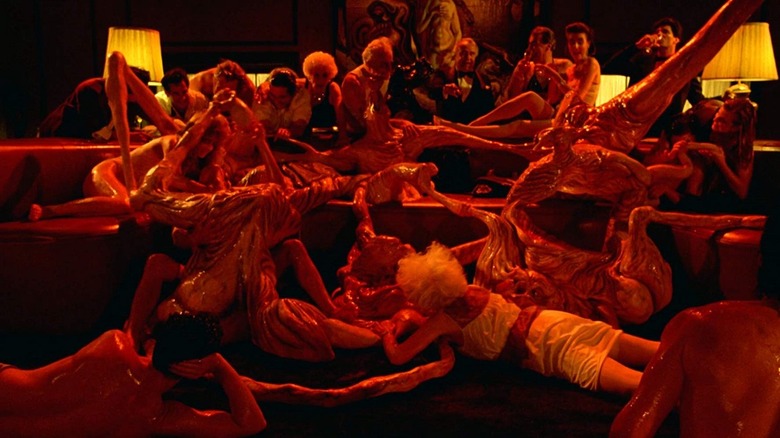
Imagine the most horrific Cronenbergian transformation scene, triple it, and you just might be able to match the horrors of Brian Yuzna's "Society."
Arguably one of the greatest body horror films in history in terms of both quality and quantity, "Society" follows a Beverly Hills teenager who discovers his wealthy parents are part of an elite social cult, but the reality of the group's initiation practice is beyond his wildest imagination. As it turns out, the wealthy elite aren't human at all, but a different species that ritualistically morph into one, gooey, thrusting, panting being in a twisted group sex event known as "shunting." Thanks to the practical effects genius of Screaming Mad George, mouths connect to orifices, faces protrude where genitals should be, limbs escape through mouths and eyes, flesh melts off the bone, and people are turned completely inside out.
"Society" is not a film for those of weak constitutions, but it provides legitimately one of the most impressive uses of practical effects you'll ever see. (BJ Colangelo)
Clown (2014)
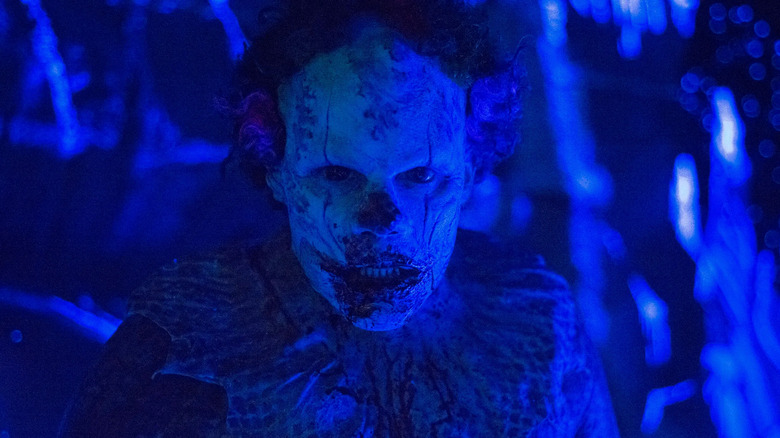
Some movie monster transformations are relatively quick; the blood test scene in John Carpenter's "The Thing" sees a man go from zero to abomination within seconds of registering a threat to his survival. Other films, like Jon Watts' 2014 body horror "Clown," prefer to let the evolution fester rather than explode.
Its main character, Kent (played by Andy Powers), is a doting father who puts on an old clown costume that he soon discovers can't be removed. The red nose and fake hair fuse to his body, but that's not the end of the change. The longer Kent is incorporated into the suit, the more erratic his behavior becomes, unearthing a primal hunger that makes his transformation less and less sympathetic as time goes on. The only way to remove the suit and live is to become a monster in the metaphorical sense as well as a visual one. Powers handles the grim emotional arc, supported by gradual prosthetic and makeup work that showcases the funnyman's deteriorating flesh as the laughs dwindle. (Anya Stanley)
Trick 'R Treat (2007)
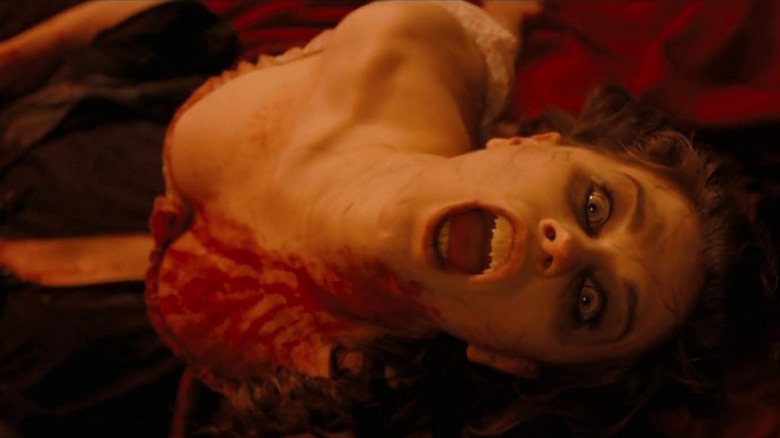
Never judge a book by its cover, or as one thrilling vignette in "Trick 'R Treat" proves, never judge a princess by her dress.
Laurie (Anna Paquin) is the youngest of four young women in revealing Disney Princess costumes headed to a Halloween party in a remote pasture. Dressed as Little Red Riding Hood, she is nervous about her "first time" and determined to find the right date. Unbeknownst to her, the man she chooses is a serial killer stalking the town's revelers.
Before Laurie can become his next victim, the wanna-be vampire crashes to the ground next to the party's raging bonfire, and he's not alone. The field is littered with incapacitated men lying helpless at their dates' feet. As the opening chords of "Sweet Dreams (Are Made of This)" begin to play, the women remove their sexy attire only to rip off their true costumes, the voluptuous female bodies they've been wearing to conceal their true forms. Werewolves in disguise, they devour their dates under the light of the full moon.
It's an intensely cathartic and empowering sequence and the audience realizes the wolves have been using cultural perceptions of feminine helplessness to hunt for men in plain sight. (Jenn Adams)
An American Werewolf In London (1981)
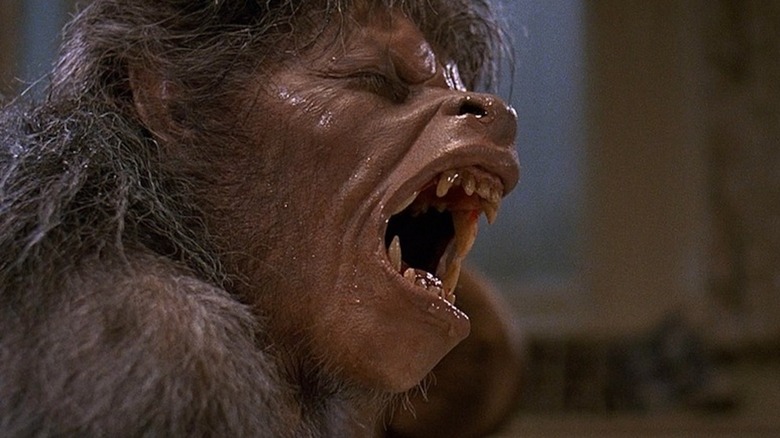
John Landis's "An American Werewolf in London" is an effortless mélange of broad comedy and sheer terror, and it all comes together in a transformation sequence that, like its werewolf forebears, evokes both awe and sorrow.
David Kessler is a good kid. Losing his best friend to a lycanthrope in the moors of Yorkshire is punishment enough. Getting turned into a murderous monster is cruel beyond belief. When the fateful full moon arrives, Kessler (David Naughton) tries to take his mind off the impending horror by watching darts. Landis taunts his protagonist with a non-diegetic "Bad Moon Rising" cue. Then the hunger hits.
David's metamorphosis runs a little over two minutes in total, an eternity in screen time. The viewer feels every excruciating elongation of hair and limbs, but it's the bone-cracking protrusion of David's jaw that drives home the pain of becoming. That Landis opts to score this torture to Sam Cooke's velvety "Blue Moon" is a pat of curdled butter on the bloodiest of steaks.
Rick Baker's groundbreaking fx work (much of which was shot in reverse) begat a generation of like-minded gorehounds, but the majority of his acolytes never matched his empathy. He thought through every second of David's unearned agony, which pays off with the film's soul-hollowing final shot. (Jeremy Smith)
The Witches (1990)
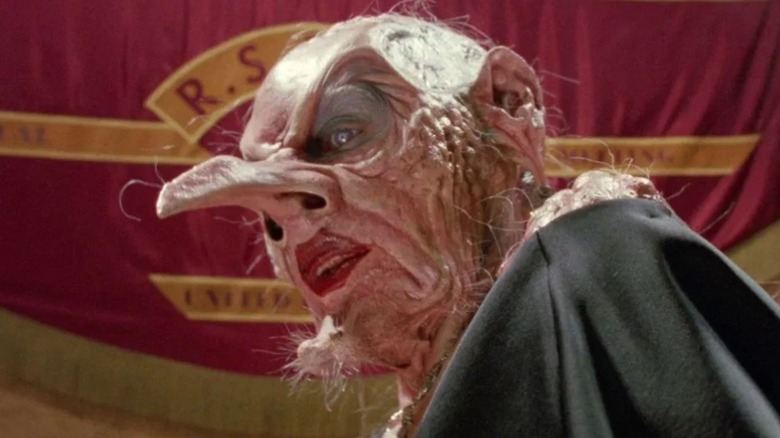
This adaptation of Roald Dahl's dark fantasy novel about a young boy stumbling into a witch convention is as creepy as creepy can get. "The Witches" is teeming with near-grotesque transformations of ordinary-looking women into something that is beyond spooky, and the film wonderfully controls its themes of dark comedy while consistently keeping up with its ghastly atmosphere.
Anjelica Huston is flawless as the Grand High Witch, the film's storyline is eerie to its core, and the concluding moments where everything blows to hell are a sight for sore eyes. Multiple transformations will send chills down your spine, but it's the conclusion that best displays how crazy this movie is: when the witches transform into mice. Their dinner party goes wrong when a potion causes their ears to protrude, their bellies to swell, and whiskers to appear on their faces before they all turn into mice. It's somehow hilarious and disturbing at the same time. (Fatemeh Mirjalili)
Indiana Jones And The Last Crusade (1989)
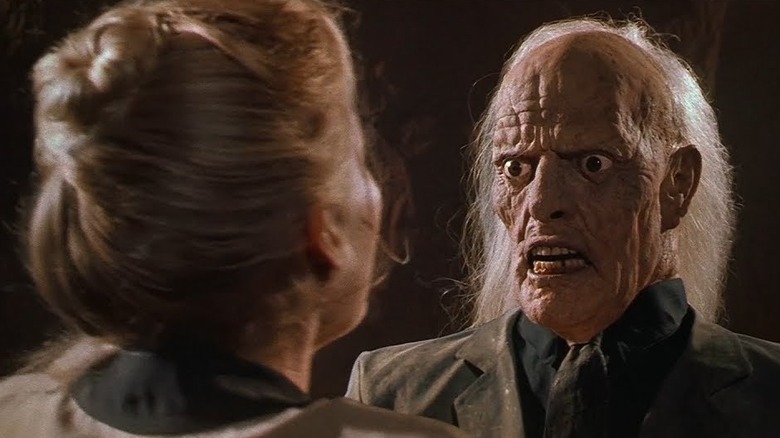
While the "Indiana Jones" films are widely recognized as being masterpieces of action-adventure, they don't get enough credit for their horrific elements. Especially the moments of comeuppance visited upon their villainous characters, with the most disturbing fates reserved for the chief baddies.
While having your face melted by the power of God or being eaten alive by crocodiles would certainly be no picnic, the most insidious punishment for an "Indy" villain occurs in "The Last Crusade," when Nazi collaborator Walter Donovan (Julian Glover) chooses "poorly" and drinks holy water from a cup that is not the Holy Grail.
Upon drinking from the wrong cup, Donovan begins to rapidly age, his hair growing while his skin dries up and shrinks before crumbling and sinking into his bones as he turns into a skeleton, swiftly shattering into dust. Not only does the scene play upon everyone's fear of aging (both naturally and before their time), but it joins the pantheon of '80s transformation sequences where a captive audience is present, as Donovan's changing hands hold tight to the duplicitous Elsa (Alison Doody). The icing on the terrifying cake lies in the fact that Donovan is moaning and shouting in fear the entire time, meaning he's all too aware of what's happening to him.
That's what you get for helping Nazis, folks! (Bill Bria)
Relic (2020)
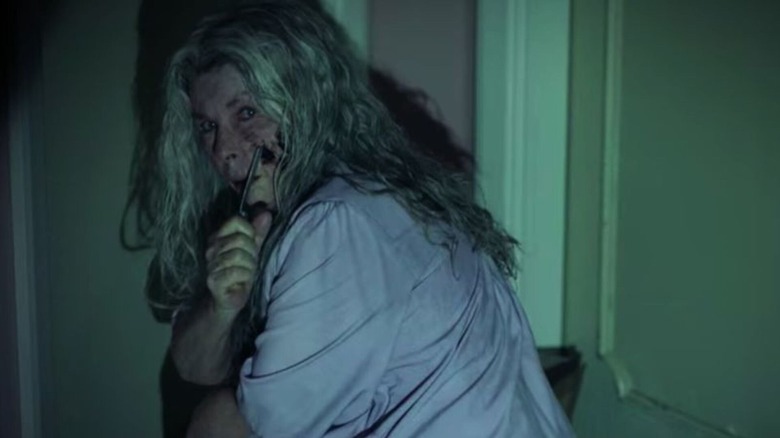
Sometimes the most terrifying aspect of a transformation sequence is not in its literal, physical mutation, but instead the knowledge of the inevitable. In the hauntingly horrific "Relic" from Natalie Erika James, the idea of generational trauma is explored through the lens of three generations of women, all of whom are at risk of becoming something monstrous.
After the elderly Edna (Robyn Nevin) goes missing, her daughter Kay (Emily Mortimer) and granddaughter Sam (Bella Heathcote) are brought in to find her, only to discover she is withering away into something unrecognizable. As Kay and Sam try their best to figure out what's happening to Edna, they must also accept that this unsettling, corpse-like transformation overtaking her will also happen to them as they grow older.
Even still, as Edna gets closer and closer to death, the women must work together to help her peel away her flesh and hair to achieve her final form, as disturbing and horrific as it may be. (BJ Colangelo)
Tusk (2014)
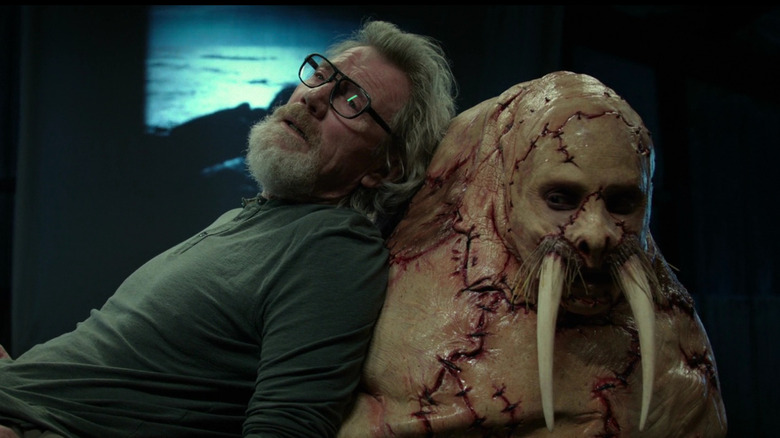
Surgical horror is a rare and taboo corner of the body horror sub genre. Something about the juxtaposition between a lifesaving procedure and the malicious intent to disfigure and deform has the unique power to disturb and horrify.
After a life of extreme trauma, eccentric madman Howard Howe (Michael Parks) becomes obsessed with recreating the walrus that once saved his life. He kidnaps and deforms callous podcaster Wallace Bryton (Justin Long), amputating his limbs and sewing him into a walrus suit made of human skin. The dismembered and sharpened bones of his own legs serve as the tusks sewn into his mouth. It's a hideous and almost comical sight as Long's soulful eyes are still recognizably human even through the massive amounts of disfiguring stitch work crisscrossing his face. Not only will he have to live with the pain his surgical wounds have caused, but his mental state collapses and he begins to see himself as a walrus.
Though Wallace manages to kill his captor, the damage has already been done. He is forced to live out the rest of his days as a human trapped in the hideous creation of a psychopath. (Jenn Adams)
Tetsuo: The Iron Man (1989)
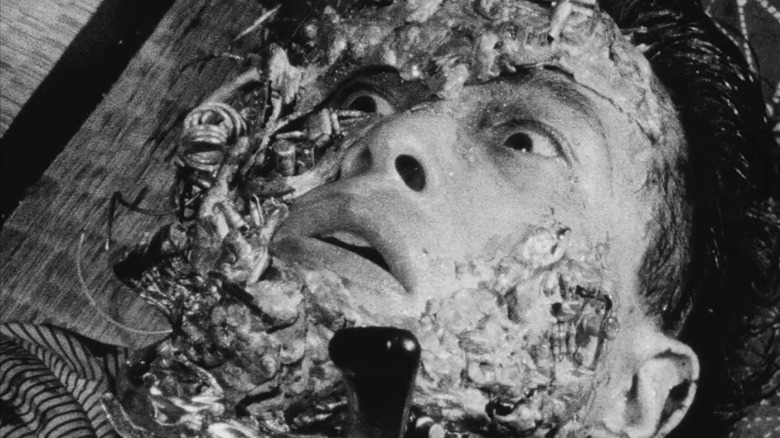
There are no movie monster transformations quite like the ones in "Tetsuo: The Iron Man." The 1989 Japanese low-budget cult classic follows two men dubbed only Man (played by Tomorowo Taguchi) and Guy (played by the writer/director, Shinya Tsukamoto) as they transform into machine men and battle it out. The plot to "Tetsuo" is practically non-existent as it instead feels more like a fever dream committed to celluloid as flesh becomes metal in increasingly violent and sexually deviant sequences.
"Tetsuo" is an experimental film about the fetishization of machinery that transforms its main characters from humans into demented sex cyborgs with grotesque growths and bizarrely replaced body parts. Hands become blades. Faces become a mess of machinery. Genitals become power drills. It's surreal stuff somehow made more horrifying by the grainy black and white footage and hand-crafted practical special effects.
While many of the other transformations on this list are slimy or sticky, this one is uncomfortably crunchy. The whole transformation begins with Man jamming a metal rod into his human leg, letting the audience know early on that this metal metamorphosis will be a gruesome one. (Danielle Ryan)
Videodrome (1983)
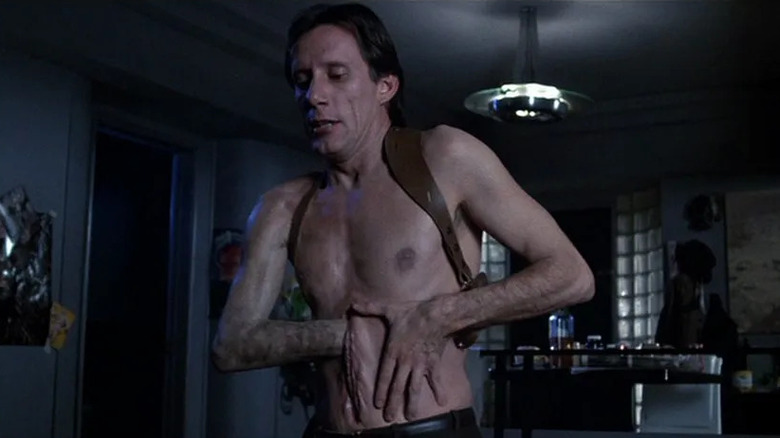
David Cronenberg's heady sci-fi feature "Crimes of the Future" is available to watch now, featuring the chaotic flesh parades that the Canadian director has become known for. But it's his 1983 science-fiction head trip "Videodrome" that comes up the most in conversations about monstrous movie transformations.
UHF station president Max Renn (James Woods) undergoes some visceral changes as he investigates a mysterious snuff show called Videodrome, but as Debbie Harry's Nicki Brand tells him, "That's only the beginning; the beginning of the new flesh." The new flesh turns out to be a horrifying amalgamation of technology and man, displayed in a gooey sequence (among many) that still repels audiences today. Renn pulls a handgun from an organic slit in his stomach and watches in awe as the weapon embeds itself into his hand and forearm.
The scene, along with the entire movie, is a repulsive yet erotic exploration of sex and violence in media and its effect on the viewer's reality. Long live the new flesh. (Anya Stanley)
Men (2022)
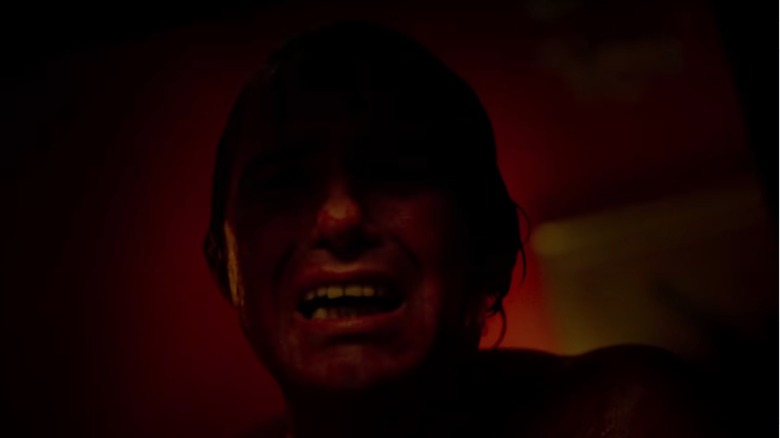
In Alex Garland's "Men," grieving widow Harper stays at an isolated house in the English countryside to rediscover herself and heal from the past. She finds the rural area lovely and charming, at least until she's followed home by a threatening nude man who disrupts Harper's attempt at tranquility. This event begins a series of interactions with misogynist boys and men, each belittling, harassing, or threatening Harper and somehow wearing the same face. It isn't until she discovers the source behind these encounters that we finally understand what's really going on.
It turns out that Harper is under attack by the Green Man, a mythical figure behind all these mysterious misogynists. In its final attack in the countryside manor, a wounded Green Man hunts Harper through the house only to stop, produce a vagina (in an ever-changing location), and essentially give birth to one of the men harassing her. The cycle repeats as it follows the widow, one form after another, leaving a trail of blood, viscera, and hollowed-out bodies behind it until Harper kills it in its final form. It's a shocking set of grotesque transformations that echo Harper's trauma and a truly disturbing final attack for the ages. (Jeff Ewing)
Evil Dead II (1987)
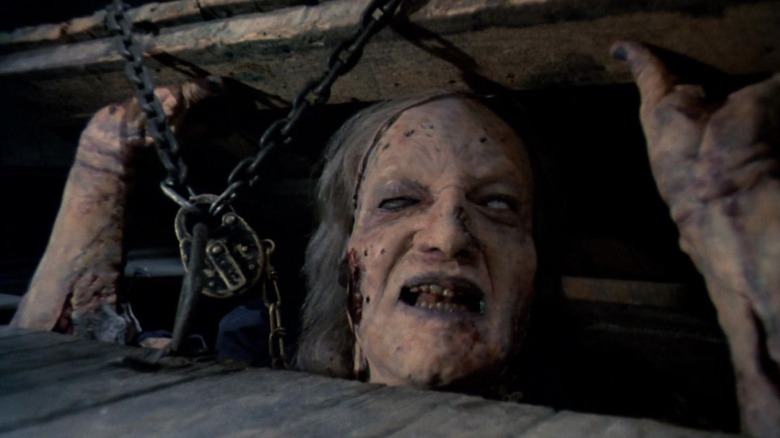
Henrietta Knowby's (Lou Hancock) transformation into a Deadite, one of the primary antagonists of "Evil Dead 2," is equal parts comical and gross.
As the first person to fall victim to the Kandarian Demon following her husband's translation of the book of the dead, Henrietta becomes a demon zombie of sorts, a parasitic ghoul that seeks to possess the bodies of mortals. The character is briefly seen attempting to attack Ash (Bruce Campbell) in the film by turning into her "gooseneck" form, which causes her neck to elongate and her decaying face to morph into a skeletal snakehead of sorts. And she can levitate, which makes things a lot spookier.
Director Sam Raimi's brother, Ted Raimi portrayed the possessed Henrietta in the film, and his scene-stealing performance was laced with equal parts terror and humor. It isn't just one of the most frightening monster transformations of all time ... but also one of the most impossibly bizarre ones. (Fatemeh Mirjalili)
Slither (2006)
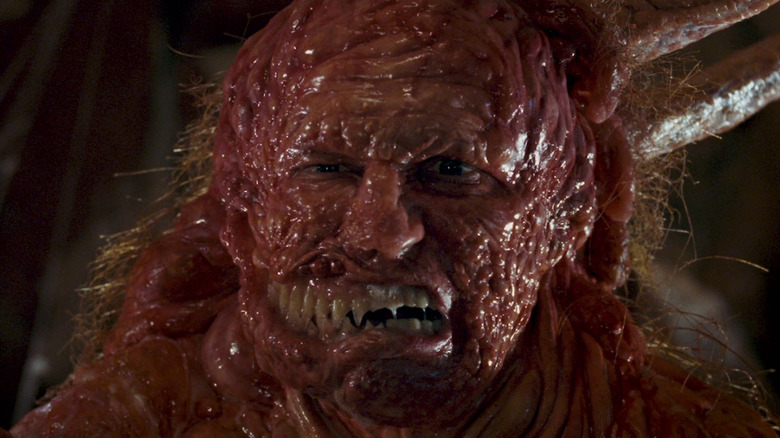
James Gunn's "Slither" is a loving homage to '70s and '80s horror, an aspect best illustrated by the fate of Grant Grant (Michael Rooker). Infected by an extraterrestrial parasite, Grant begins gradually transforming into a hybrid creature whose sole purpose is to infect and transform every living thing into itself.
While Grant's transformation is gradual, it's still gooey and grotesque, with artist Todd Masters responsible for blending Rooker's features with slimy, organic-looking prosthetics. Even more disturbing is the fate of those Grant chooses to become breeding receptacles for his slug-like parasites. As poor Brenda (Brenda James) demonstrates, such victims remain alive during the process and are eventually torn apart by the writhing slugs inside them.
Grant's final form is like an unholy mash-up of the shunting from "Society" and the semen pool from "Breeders," a mass of writhing bodies and tentacles that looks both menacing and disturbingly sexual, indicating Grant's purpose on Earth is about more than just a threat of death. Most body transformations in horror films have an element of sexual anxiety, and the creature's design in "Slither" incorporates that, keeping it horrific even when the film itself goes for comedy. (Bill Bria)
Jennifer's Body (2009)
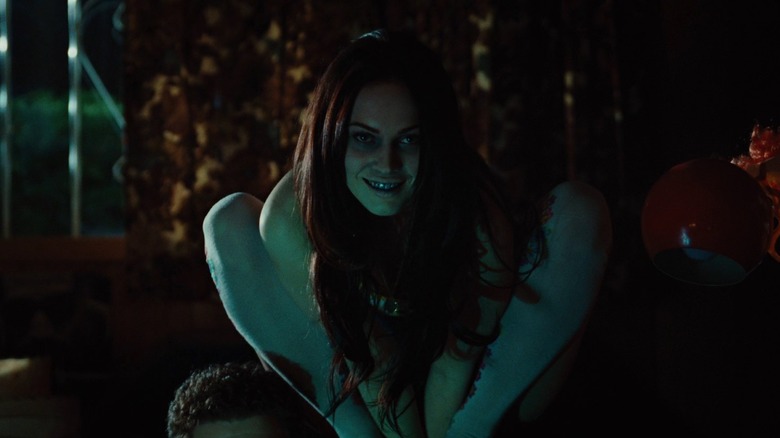
Jennifer Check has spent her entire life being the hottest girl in Devil's Kettle, which is perhaps what makes her transformation into a monster all the more terrifying.
After the wannabe rock band Low Shoulder tries and fails to sacrifice Jennifer to the devil in exchange for a music career, Jennifer slowly transforms into a boy-eating succubus with the ability to unhinge her jaw, grow sharp teeth, and consume anyone who crosses her. Before she fully comes to terms with what's happening to her, she vomits black sludge, loses all color in her complexion, her teeth slowly begin to rot, and her hair grows limp and weak. When Jennifer learns she can combat the visible signs of decay by feeding on men, she becomes more powerful than ever.
Jennifer Check is the definition of the monstrous feminine in that her transformation is most terrifying for those that get in her way. Even when she's devouring raw meat and spitting blood, Jennifer Check is still the hottest girl in Devil's Kettle, and that's what makes her so dangerous. (BJ Colangelo)
Sorry To Bother You (2018)
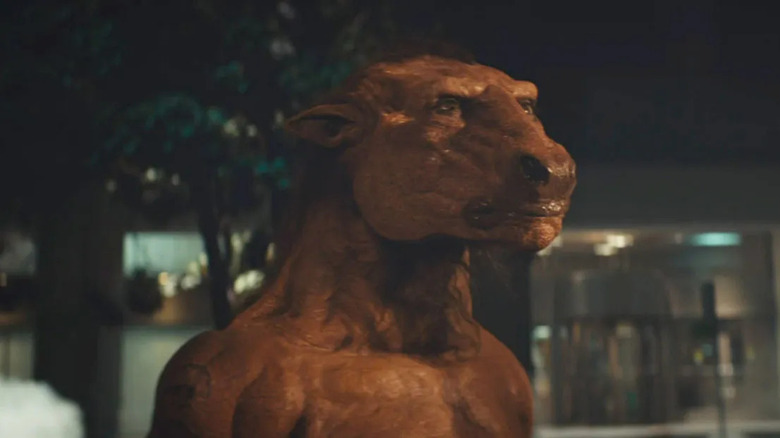
With his 2018 surrealist dark comedy "Sorry To Bother You," writer-director Boots Riley has some inconvenient truths to deliver. That's partially what the film's title is about: not only is it commonly used by telemarketers as they make sales calls at the most unsuitable times, but the phrase captures the cumbersome feeling that comes with delivering those earth-shattering truths.
In the film's case, that "bother" is a feature-length interrogation of capitalism and how easily it commodifies its laborers. Refract that through Riley's unapologetic magic realism, and the message calls for an unforgettable visual depiction of a dystopian workforce through the animal most associated with labor: the horse.
While a corporate workforce's transition from man to "Equisapien" in the movie isn't presented with the tonal terror of a werewolf transformation, there's something repugnant about seeing such an extreme iteration of slave labor and becoming a cog in an evil machine. But don't worry, the half-horse men do get something like a happy ending ... once they organize. (Anya Stanley)
Hellraiser (1987)
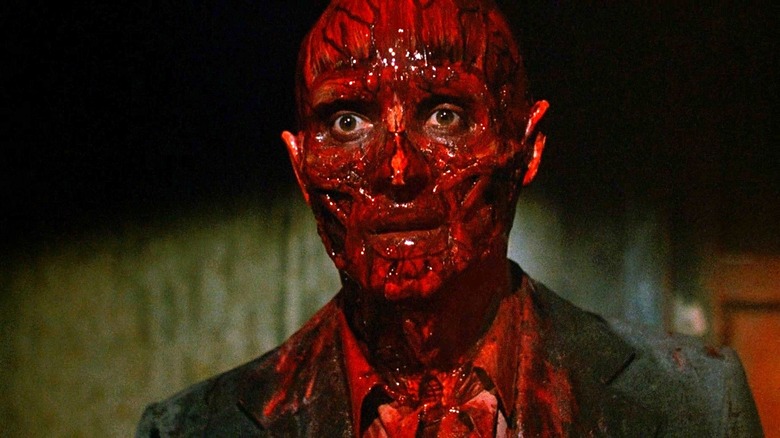
Clive Barker's 1987 "Hellraiser" marks the cinematic debut of the Cenobites, powerful sadomasochistic extradimensional torturers who serve the misanthropic entity known as Leviathan. Cenobites torment the souls of those unfortunate enough to solve the Lament Configuration puzzle box, and in "Hellraiser," that unfortunate soul is hedonist and scoundrel Frank Cotton. Bored with Earthly pleasures, Frank solves the infamous puzzle box in search of the ultimate hedonistic rush. Getting more than he bargained for, Frank is instead ripped apart and taken to hell by the Cenobites until a chance splatter of blood in the attic where he died allows him to return to our world.
He returns as an incomplete, slimy, skinless version of himself, convincing his former lover and sister-in-law Julia to seduce victims into the attic. Each drop of blood gradually restores Frank's flesh in a grotesque and monstrous series of transformations. In his final form, the villain even kills and wears his own brother's skin before the Cenobites recapture him, unapologetic and evil to the last.
As far as monstrous transformations go, few are more visually and conceptually terrifying than a murderous sex-fiend made up of a growing amalgamation of bone, flesh, veins, and goo, a rare monster whose moral depravity matches or exceeds his inhuman exterior. (Jeff Ewing)
Tokyo Gore Police (2008)
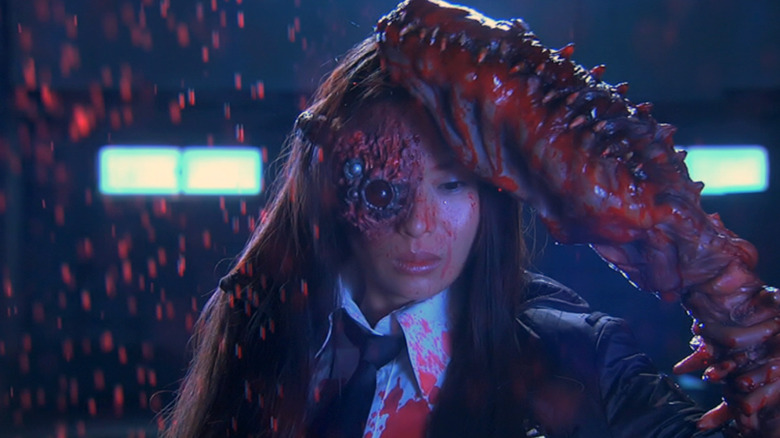
Legendary Japanese special effects artist Yoshihiro Nishimura directed "Tokyo Gore Police," and nearly every single shot makes use of his transformative talents. The movie is set in a near-future dystopian version of Japan where a mad scientist has created a virus that mutates people into monstrous beings called "Engineers." In order to combat the Engineers, a special squad of the Tokyo Police Force hunts them down, including the mysterious and vengeful Ruka (played by Eihi Shiina). Ruka dispatches the mutated Engineers with ease, but ends up infected by the mad scientist and begins her own transformation.
"Tokyo Gore Police" is a movie about a virus that causes severe mutations, so it contains too many disgusting transformations to possibly mention. Among them is a woman who becomes half snail, another woman whose lower limbs turn into a massive pair of reptile jaws, someone who becomes a living chair, and an amputee with swords for arms and legs. Ruka's own change is less extreme, but she still ends up with a claw arm and a big, demonic-looking eye.
"Tokyo Gore Police" isn't for everyone, but it's perfect for fans of disgusting transformations. (Danielle Ryan)
The Wolf Man (1941)
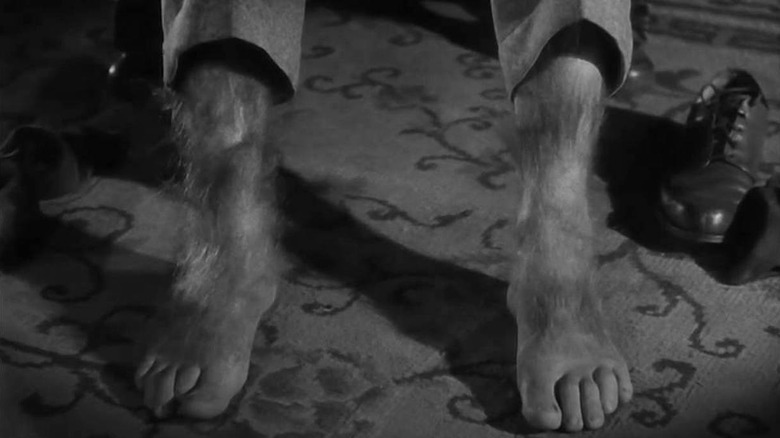
As the son of Lon Chaney, Hollywood's celebrated "Man of a Thousand Faces," Lon Chaney Jr.'s transformation from Larry Talbot to the Wolf Man had to be something special. Realizing this, makeup fx artist Jack Pierce did the counterintuitive thing and underplayed the shift from man to beast. This placed the onus on Chaney Jr., who'd proven himself as an actor with his hugely sympathetic portrayal of Lennie in Lewis Milestone's 1939 adaptation of John Steinbeck's "Of Mice and Men."
When the full moon hits, Talbot flees for home, hoping the sorceress Maleva's lupine prophecy is little more than old-world balderdash. Talbot frantically paces his flat and examines himself in a mirror. Same old Larry. He briefly beams with relief until he senses something's not quite right with his feet. He sits and peels off one sock and then another. Furry as all get out. After a series of dissolves, his feet are wholly lycan.
Director George Waggner abruptly cuts to the moors, where the viewer finally sees Chaney in full monstrous makeup. The audience feels both terror and pity, all due to Chaney's devastating realization that he is a doomed man. (Jeremy Smith)
Starry Eyes (2014)
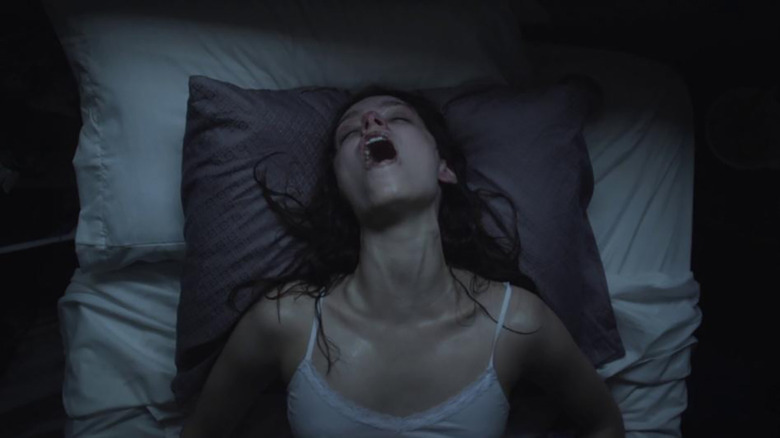
Sometimes, settling into a social group requires transformation, but in "Starry Eyes," Sarah (played by Alex Essoe) takes that concept a little too far. An aspiring actress in Los Angeles, Sarah gets stuck working a soul-sucking restaurant gig with friends who treat her as disposable. When she's offered the chance to become a part of the Hollywood elite at the cost of her actual soul, she reluctantly agrees and begins one of cinema's most gruesome transformations.
After being infected by evil in a semi-coerced sexual act with a high-powered producer, Sarah's body begins to change. The movie shifts from an unpleasant psychological and social horror story into pure body horror as her hair and nails begin to fall out, her skin turns a sickly greenish shade, and she starts vomiting maggots. Eventually, she goes into a kind of cocoon and emerges as a pale, flawless, hairless version of herself with glowing green eyes, but the journey to that point is harrowing. (Danielle Ryan)
Black Swan (2010)
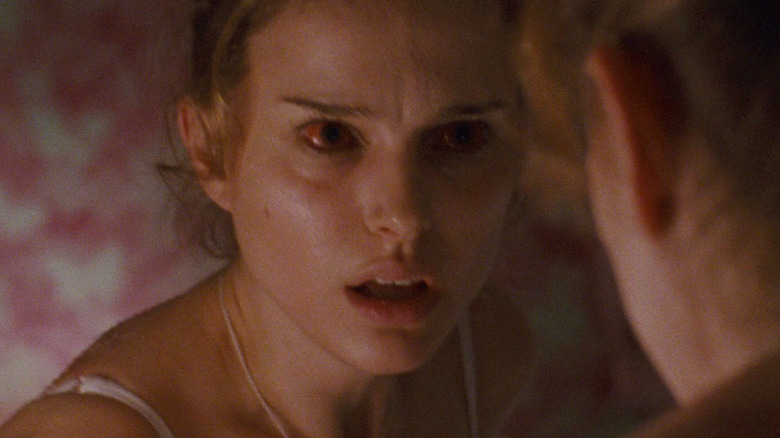
The world of ballet revolves around transforming the body into a picture of impossible perfection, but as Darren Aronofsky's "Black Swan" shows, the truth behind this dainty facade can be terrifying.
Nina (Natalie Portman) is a veteran dancer hoping for the lead in a new production of Swan Lake. Pulled between her manipulative mother and egotistical director, she becomes obsessed with embodying the two sides of the Swan Queen. The White Swan is pristine, delicate, and docile while the wild Black Swan is guided by impulse and desire.
As opening night approaches, Nina finds herself pushed past her limits, desperately seeking the dichotomy of imperfect perfection. The Black Swan takes over, putting her body through a hideous transformation. Nina's legs crack and bend. Her eyes fill with blood and she begins to sprout feathers from her arms and back. Perhaps only in her mind, this metamorphosis helps her deliver the performance of a lifetime. Unfortunately, it's also her last.
While trying to hide these disfigurements, she drives a shard of glass deep into her stomach. After her final leap, Nina lies bleeding behind the curtain, dying but basking in the glow of this monstrous perfection. (Jenn Adams)
The Exorcist (1973)
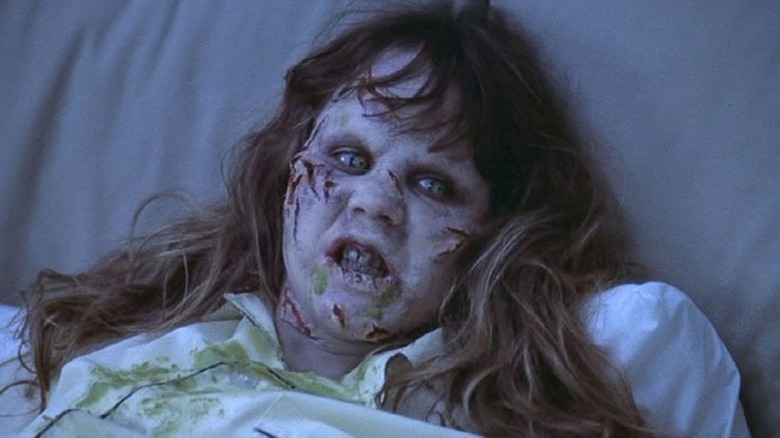
In William Freidkin's "The Exorcist," young Regan MacNeil (Linda Blair) becomes increasingly ill after reporting interactions with an imaginary friend she calls Captain Howdy. It turns out he's actually a guise for the powerful demon Pazuzu who has come to take up residence in poor Regan's body. In nightmarish fashion, Regan transforms from a kind young girl into something different entirely as the possession takes hold.
Pazuzu turns every aspect of Regan into something barely recognizable. The once adorable young girl becomes covered in corpse-like pale skin that's heavily scratched and bruised. Her eyes turn a menacing, otherworldly green. She grows stronger, and capable of both levitation and spitting a stream of inhuman, ectoplasm-like vomit. As unnatural and grotesque as these physical transformations are, however, what makes Regan's mutation truly terrifying is how thoroughly Pazuzu has emptied out and possessed the shell that is her body, repeatedly altering her voice as the demon manipulates, threatens, and attempts to deceive the investigating priests.
So terrifying was Regan's appearance that reports of fainting and heart attacks in the audience circulated widely on its release, cementing its status as one of cinema's most terrifying transformations. (Jeff Ewing)
Dr. Jekyll And Mr. Hyde (1931)
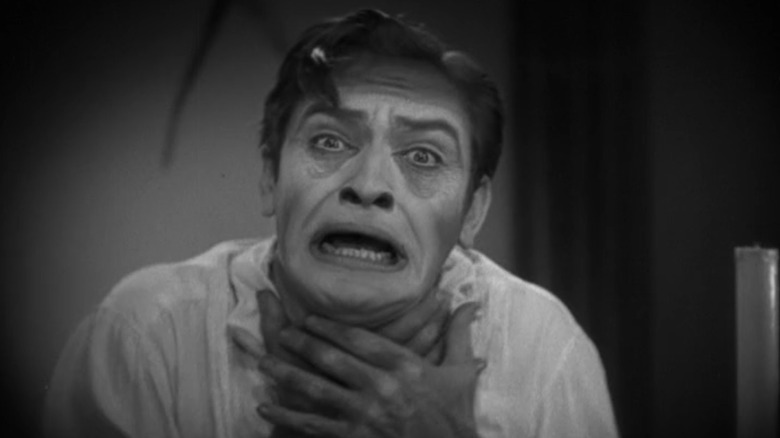
Moviegoers were still marveling at the advent of the "talkie" when director Rouben Mamoulian knocked them sideways with one of the most astonishing monster transformations in film history. When Frederic March's mild-mannered Dr. Henry Jekyll bolts down a druggy cocktail designed to draw out the beast he believes resides inside every man, Mamoulian frames the actor in agonizing close-up.
As Jekyll writhes in pain, the camera pans down to his right hand. It darkens. When the camera pans back up, Jekyll's thin eyebrows are bushier, his hair thicker, and most alarmingly, his teeth ... well, they're fang-ier. The camera then dives down to his left hand, which turns disgustingly hirsute. By the time the camera returns to Jekyll's visage, he is Mr. Hyde, a snarling monster of a man capable of unthinkable evil. Mamoulian lets us gape for a second before directing March to look directly at the camera.
Mamoulian refused for decades to reveal the secrets of the transformation. When he did, it was a shockingly simple combination of filters and contrastingly colored makeup, all of which was concealed when captured on black-and-white film stock. The effect is still seamless and utterly terrifying. (Jeremy Smith)
Read this next: The 15 Best Final Girls In Horror Movies Ranked
The post The Most Terrifying Movie Monster Transformations appeared first on /Film.
0 Commentaires